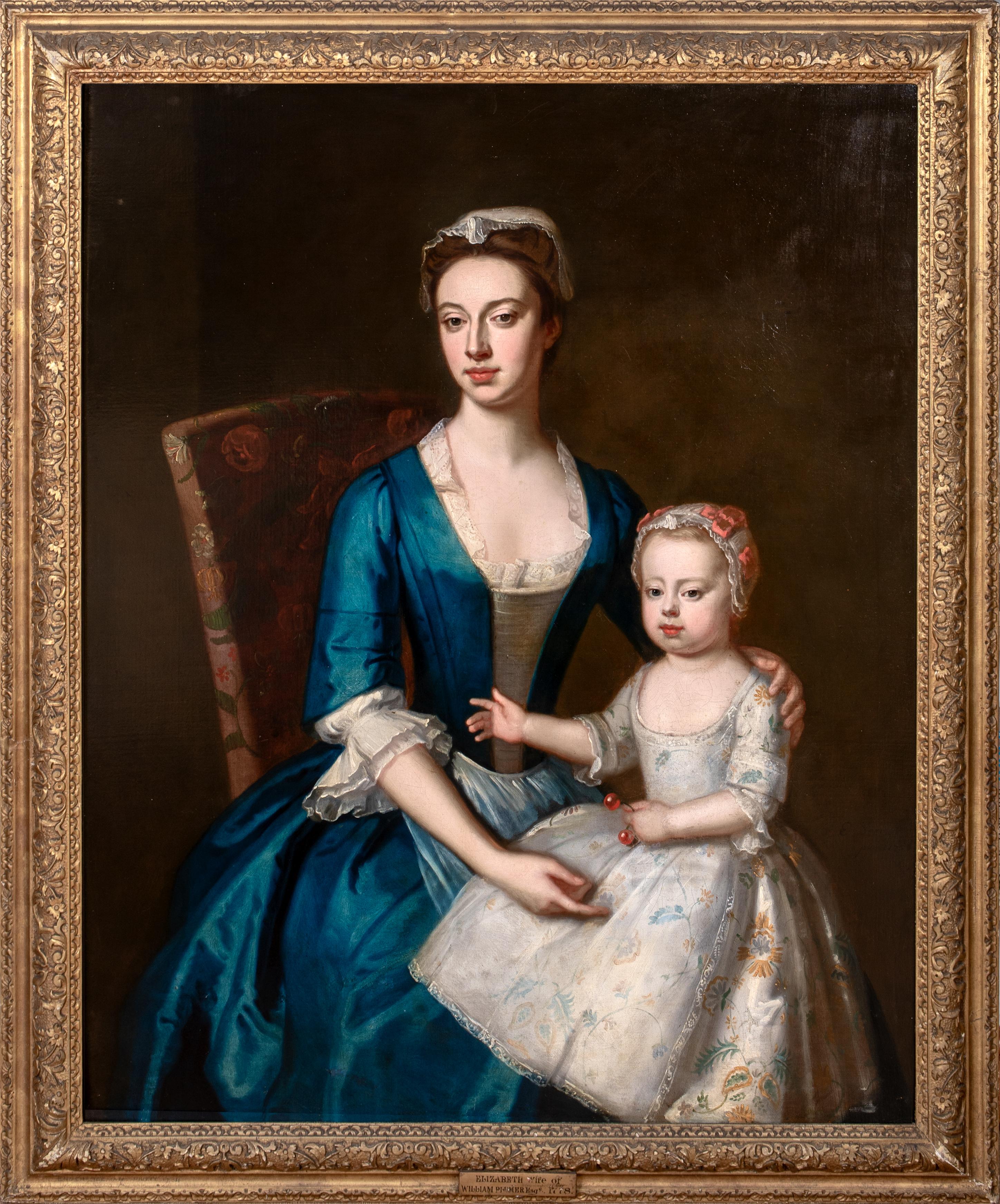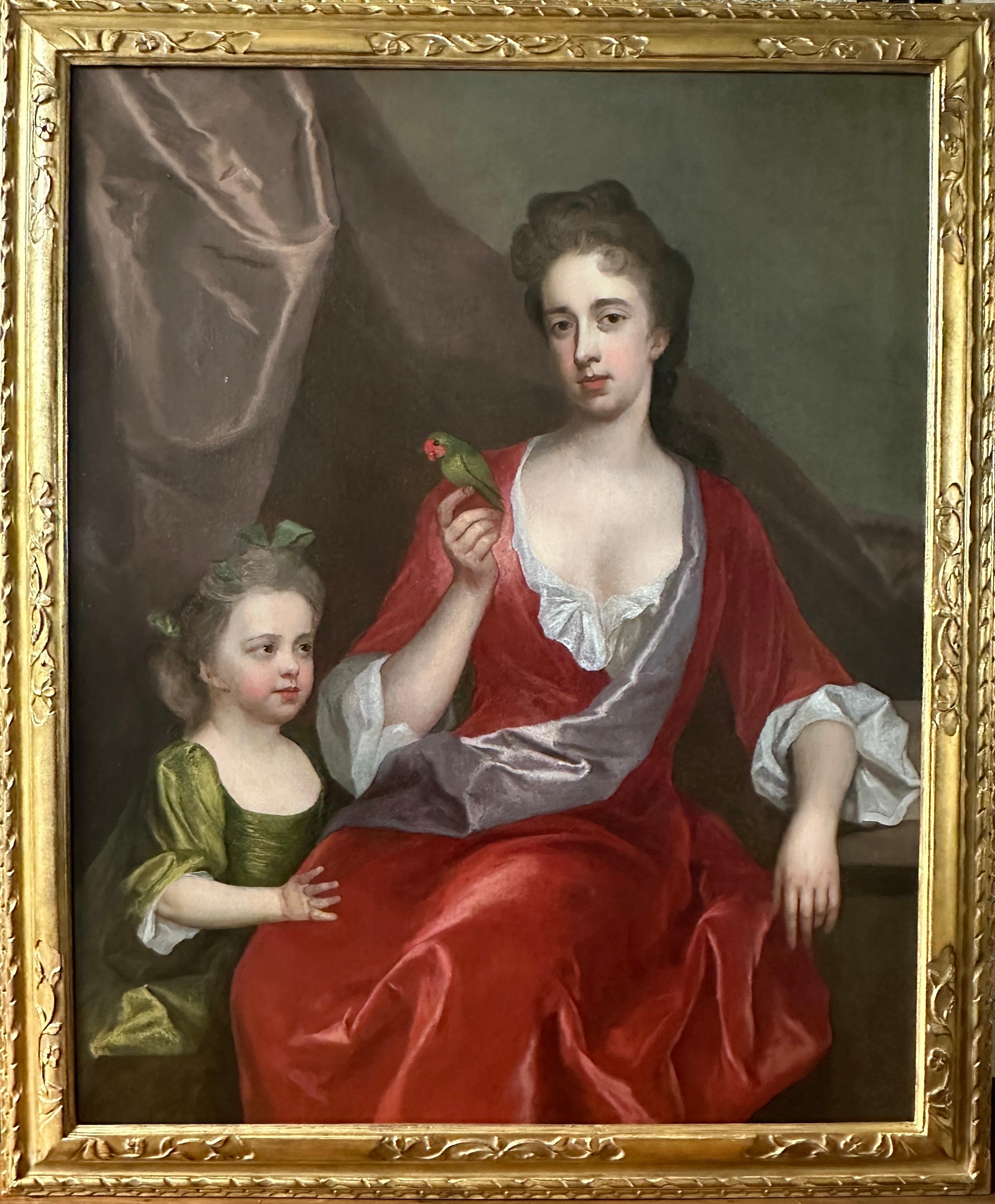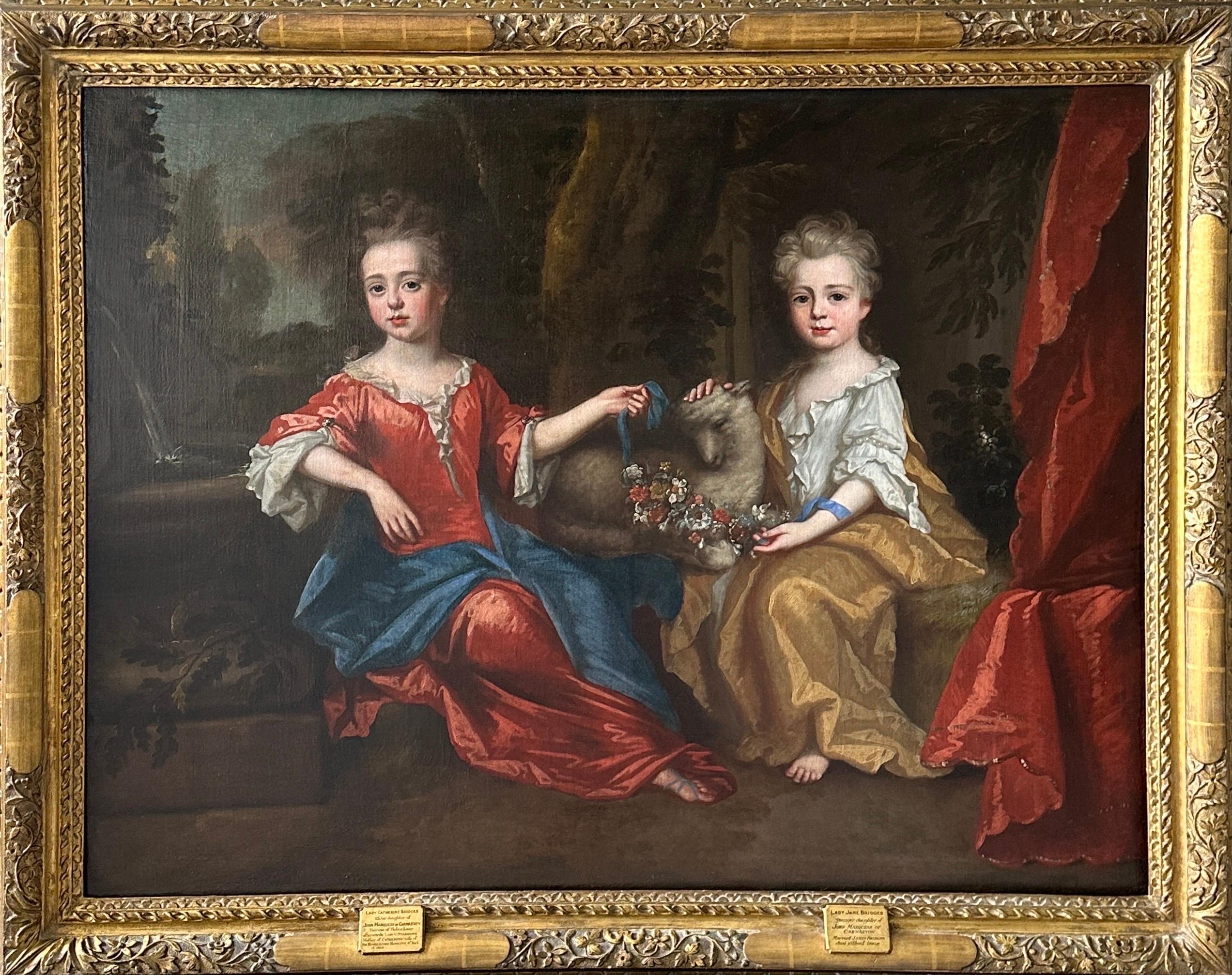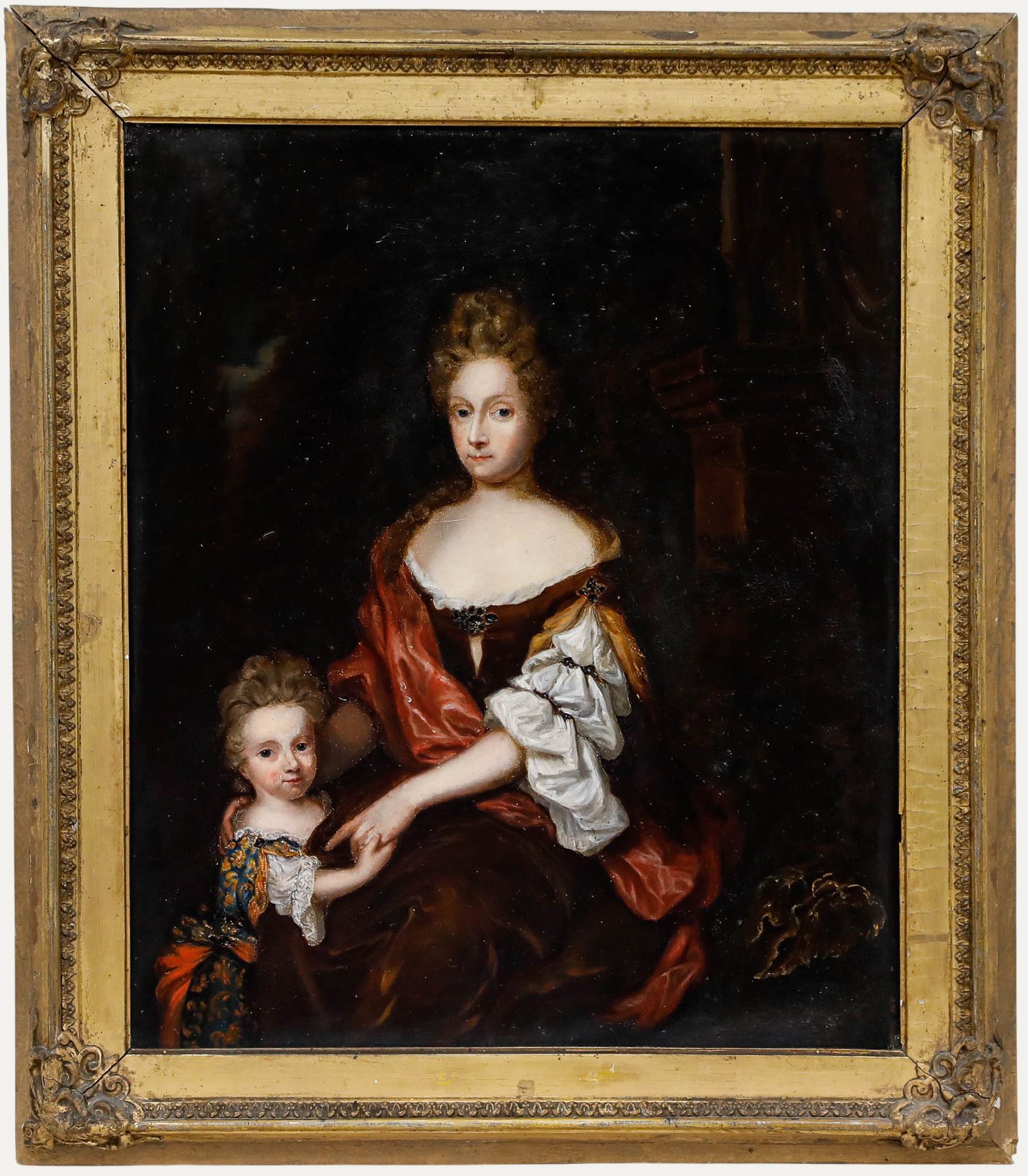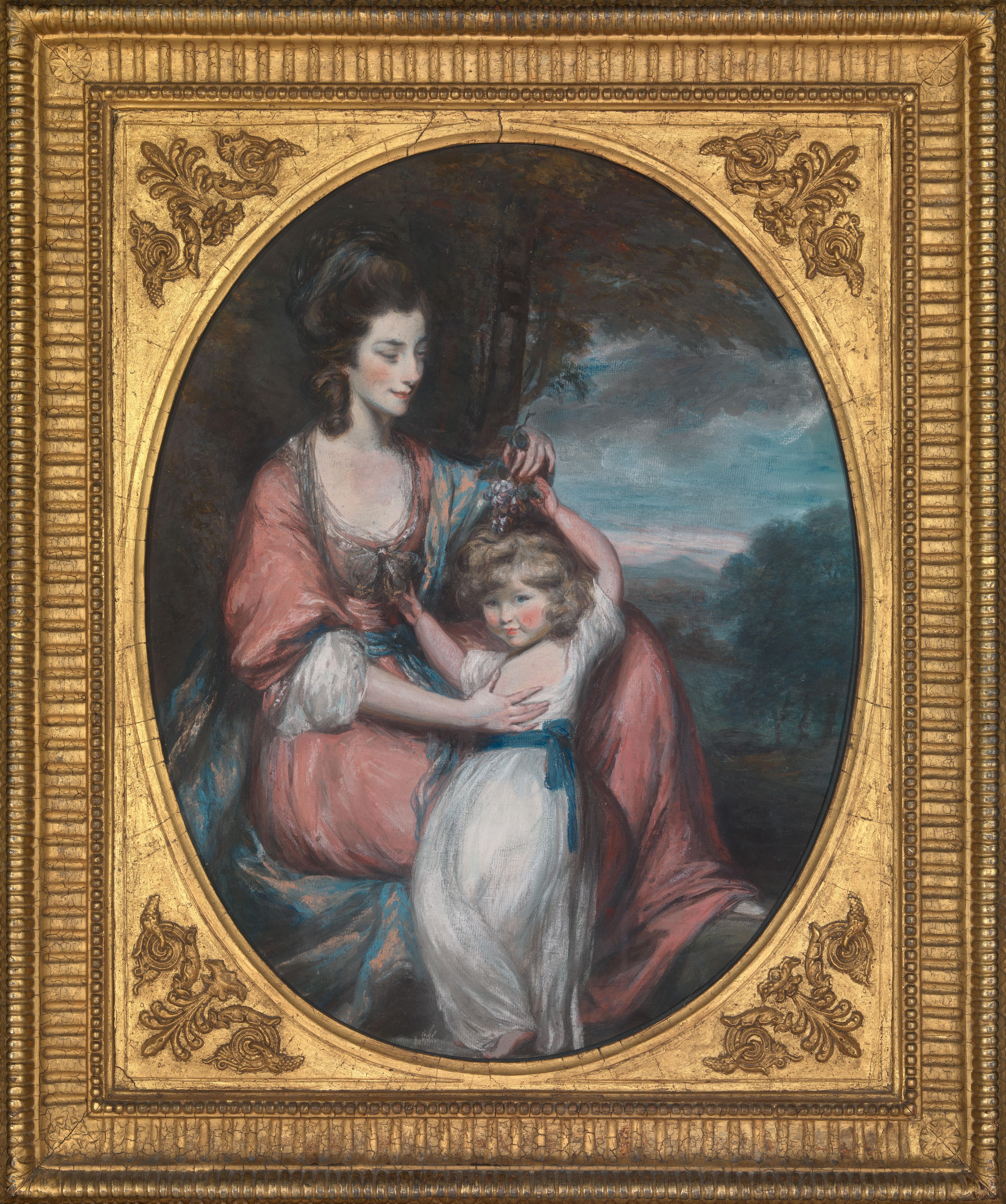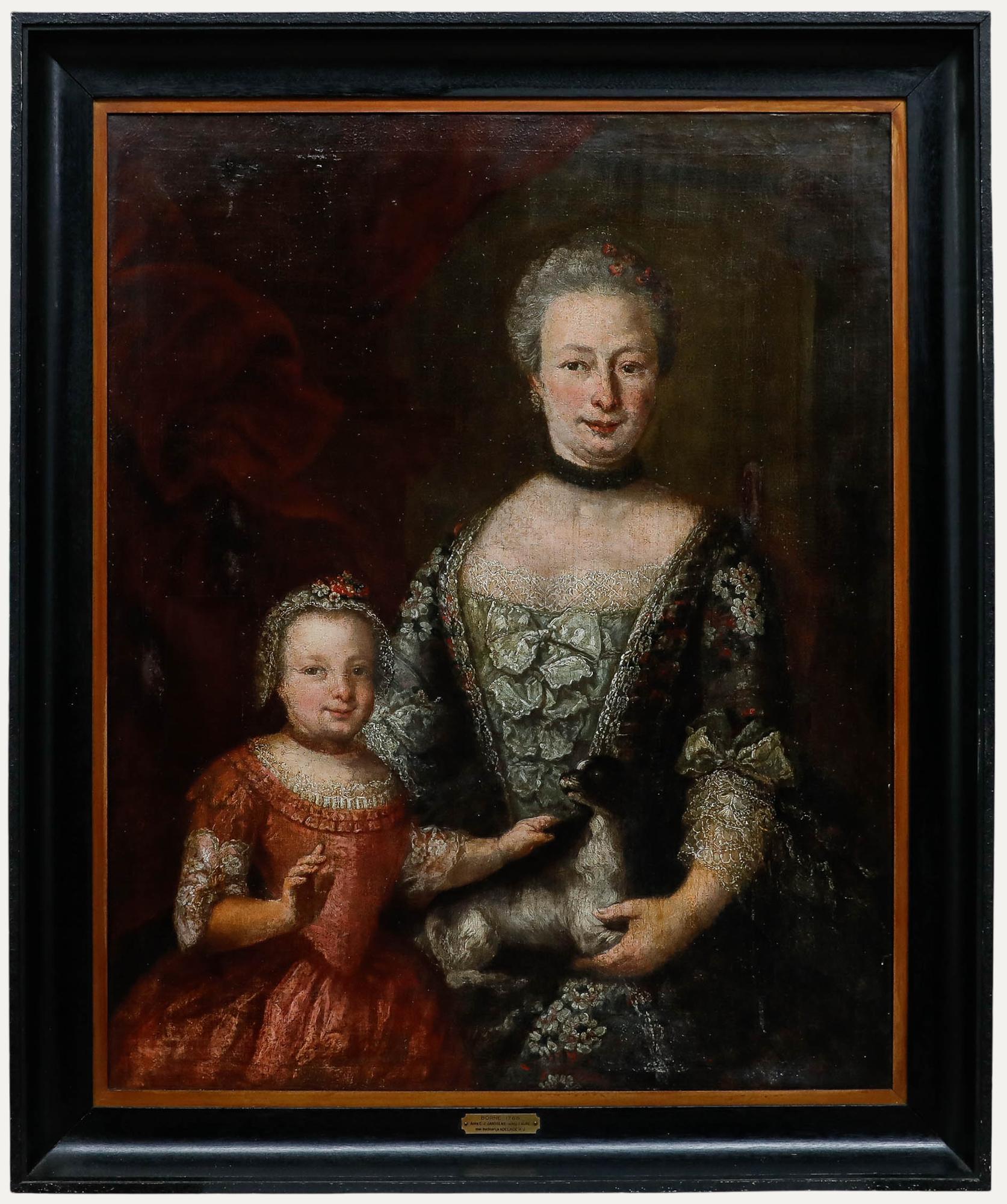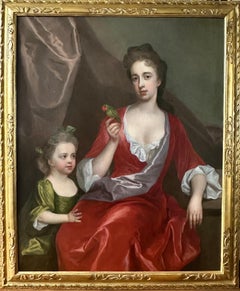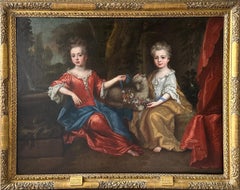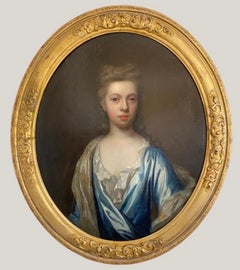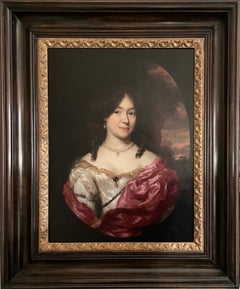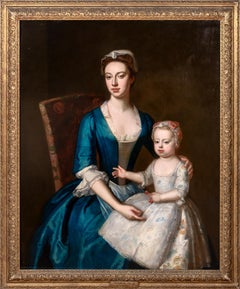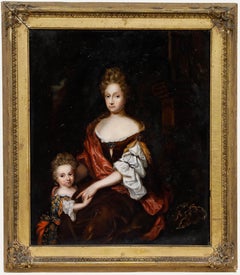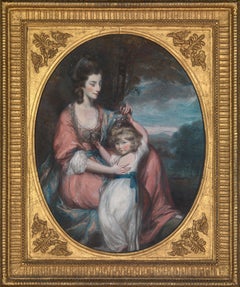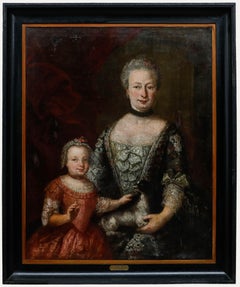Items Similar to English 18th century portrait of a Lady and her Daughter in an interior
Video Loading
Want more images or videos?
Request additional images or videos from the seller
1 of 11
(attributed to) Joseph HighmoreEnglish 18th century portrait of a Lady and her Daughter in an interiorcirca 1720
circa 1720
$24,701.59
£18,000
€21,164.22
CA$34,106.10
A$37,821.15
CHF 19,872.21
MX$462,110.13
NOK 248,628.42
SEK 233,380.25
DKK 157,995.07
About the Item
Portrait of a lady, three-quarter length, wearing a blue silk gown, seated in a classical interior, with her daughter in a pink gown standing beside her holding a sprig of blossom. This charming portrait conveys the close bond between the mother and young child with the sprig of blossom symbolising the innocence and purity of the young girl's nature. The colour palette of blues and pinks used in the clothes combined with the blush pink in the facial skin tones suggesting a healthy glow, make this a particularly attractive composition. Circa 1720.
Joseph Highmore (1692–1780), was an English painter, born on 13 June 1692 in the parish of St James in the City of London, the third son of Edward Highmore, a coal merchant, and his wife, Maria, née Tull. From 1702 to 1704 he attended Merchant Taylors' School in London, and from 1707 trained as a lawyer. Highmore was, however, determined to pursue a career as an artist, no doubt in emulation of his uncle Thomas Highmore (1660–1720), the serjeant-painter. During his training he attended the anatomical lectures of William Cheselden and Sir Godfrey Kneller's drawing academy. One of his earliest known portraits, of the ivory carver David le Marchand (c.1723; NPG), reveals Highmore's debt to Kneller at his most vivacious. In 1715, freed from the law, he established a successful portrait-painting practice, and on 28 May 1716 he married Susanna Hiller, with whom he had two children, Anthony and Susanna. In 1724 the Highmores moved from the parish of St Swithin in the City of London to a house on the north side of the more affluent Lincoln's Inn Fields, an indication of Highmore's professional success .
Highmore's clientele came predominantly from the wealthy gentry or professional middle classes. Unusually among artists of the period, he did not use students or drapery painters; as he proudly wrote: 'I do every thing my self, which I believe is not true of one painter in England besides' (letter to James Harris, 23 March 1741).
- Creator:(attributed to) Joseph Highmore
- Creation Year:circa 1720
- Dimensions:Height: 57.49 in (146 cm)Width: 47.64 in (121 cm)
- Medium:
- Movement & Style:
- Period:
- Condition:
- Gallery Location:Bath, GB
- Reference Number:1stDibs: LU95210866742
About the Seller
5.0
Vetted Professional Seller
Every seller passes strict standards for authenticity and reliability
Established in 2002
1stDibs seller since 2015
37 sales on 1stDibs
Associations
The British Antique Dealers' AssociationLAPADA - The Association of Arts & Antiques DealersInternational Confederation of Art and Antique Dealers' Associations
- ShippingRetrieving quote...Shipping from: Bath, United Kingdom
- Return Policy
Authenticity Guarantee
In the unlikely event there’s an issue with an item’s authenticity, contact us within 1 year for a full refund. DetailsMoney-Back Guarantee
If your item is not as described, is damaged in transit, or does not arrive, contact us within 7 days for a full refund. Details24-Hour Cancellation
You have a 24-hour grace period in which to reconsider your purchase, with no questions asked.Vetted Professional Sellers
Our world-class sellers must adhere to strict standards for service and quality, maintaining the integrity of our listings.Price-Match Guarantee
If you find that a seller listed the same item for a lower price elsewhere, we’ll match it.Trusted Global Delivery
Our best-in-class carrier network provides specialized shipping options worldwide, including custom delivery.More From This Seller
View AllA portrait of a lady and her daughter with an exotic bird
By Michael Dahl
Located in Bath, Somerset
A portrait of a lady three-quarter length, seated in an interior, wearing a red silk gown draped in a pink silk sash with an exotic bird perched on her hand and one arm resting on a stone plinth, her young daughter wearing a green silk gown standing at her side.
Oil on canvas, housed in a period 'Lely' giltwood frame.
This double portrait was painted at the height of Dahl's career in circa 1715 when Dahl had become firmly established as one of the leading portrait painters in Britain. Although the identities of the sitters are currently unknown, it is a sensitive depiction of a close and affectionate bond between a mother and daughter, with the young girl's hand resting affectionately on her mothers lap. The tamed exotic bird adds a charming decorative element which also serves to convey the high social status of the lady, given only the very wealthy would be able to own such a rare and expensive pet and the lively colouring of the bird's feathers is reflected in the colours of the sitters' silk gowns.
Provenance: Private collection, London
Michael Dahl (Stockholm 1659-1743 London) was born in Stockholm in Sweden and studied under Martin Hannibal (d 1741) and later with David Klöcker Ehrenstrahl. In 1682 he travelled to London, where he became acquainted with Godfrey Kneller and Henry Tilson, and in 1685 he left for Europe with Tilson, working briefly in Paris before continuing to Venice and Rome, where they stayed for about two years. In Rome Dahl converted to Roman Catholicism and gravitated towards the circle of Christina, former Queen of Sweden, who sat for him (Grimsthorpe Castle, Lincs). He returned to England with Tilson via Frankfurt and arrived in London in 1689, staying in England for the remainder of his career.
During Dahl's absence, Kneller had consolidated his supremacy in London as the most fashionable portrait painter, but Dahl rapidly became Kneller’s closest competitor. His patrons probably had roots in the Swedish diplomatic circles, but it expanded as a result of his ability and his agreeable personality. His prices were lower than those of Kneller and he favoured softer, more diffused, colour tones and could respond to his sitters with sincerity and humanity. Politically, Kneller supported the ascendant Whigs while Dahl was a Tory, but they frequently painted the same sitters from both parties, and in spite of fundamental differences in technique and temperament, their work was sometimes similar in appearance.
Dahl was prolific but rarely signed his work, and comparatively few of his portraits were engraved in mezzotint, the method used by Kneller to widen his reputation. By 1690 he had painted the aged Duke of Schomberg (engraved by William Faithorne) and Prince George of Denmark (London, Kensington Palace). He was ignored by William III but received commissions from Princess Anne, including one for a portrait of herself (Oakly Park, Ludlow, Salop). He also painted the future Duke and Duchess of Marlborough, and his informal portrait of the Duchess (Althorp House, Northants), formerly attributed to Kneller, is perhaps the most intimate of all images of her.
During the 1690s he secured the patronage of Charles Seymour, the ‘Proud’ 6th Duke of Somerset, who ordered a series of seven full-length portraits of notable contemporary beauties from Dahl (1690s; Petworth House, W. Sussex, NT). This was originally a scheme similar to Kneller’s more famous ‘Hampton Court Beauties’, but the portraits were subsequently reduced to three-quarter-length formats. The features of the sitters are not individualized, but they possess a decorative, languorous glamour that recalls Lely rather than Kneller. Somerset gave Dahl further employment over the next 25 years.
In 1698, following the death of Klöcker Ehrenstrahl, Dahl was offered the post of court painter at Stockholm, which he apparently refused, preferring to remain in London at his studio in Leicester Fields, near the Swedish legation. In about 1700 he was joined by a young compatriot, Hans Hysing, who worked with him for many years. Dahl seems not to have married until after 1708, He had a son Michael (d. 1741), also a painter, of whose work nothing is known, and two daughters.
After the accession of Queen Anne in 1701, she and Prince George sat for a number of official portraits. His royal patronage ceased with Queen Anne’s death, and when Dahl refused to paint the infant Duke of Cumberland in 1722. He was suspected of Jacobite sympathies, and relations had cooled between him and the Swedish legation. However, his practice continued to prosper, and he acquired another important patron in Edward Harley, 2nd Earl of Oxford, who shared his political views and whose circle included the architect James Gibbs and the poets Matthew Prior and Alexander Pope, all of whom Dahl painted. Oxford commissioned several portraits of himself. In the earliest (1719; Welbeck Abbey...
Category
Early 18th Century Old Masters Portrait Paintings
Materials
Canvas, Oil
$26,348 Sale Price
20% Off
18th century portrait of sisters Lady Catherine and lady Jane Brydges
By James Maubert
Located in Bath, Somerset
This large double portrait depicts the sisters Lady Catherine and Lady Jane Brydges, the daughters of John Brydges, the Marquess of Carnarvon (1703-1727). They are seated on a stone...
Category
Early 18th Century Old Masters Portrait Paintings
Materials
Canvas, Oil
English 18th century portrait of a lady, Circle of Thomas Murray (1663-1735)
Located in Bath, Somerset
An early 18th century portrait of a young lady, half length, wearing a blue silk gown with white chemise and gold trimmed cloak draped across her arm and shoulders. Her sensitively observed soft expression and skilfully painted youthful 'dewy' complexion are reminiscent of the portrait style of John Closterman whose work Murray would have been familiar with, being a close colleague of Murray's teacher, John Riley.
An old label on the reverse identifies the sitter as a young Princess Charlotte...
Category
Early 18th Century Old Masters Portrait Paintings
Materials
Canvas, Oil
$8,218 Sale Price
20% Off
17th century portrait of a lady
By Nicolaes Maes
Located in Bath, Somerset
Portrait of a lady by Dutch Golden Age painter Nicolaes Maes (1634-1693). Half-length, within a feigned oval, the lady wears a pearl necklace and earrings, an ivory silk gown adorned...
Category
17th Century Old Masters Portrait Paintings
Materials
Canvas, Oil
18th century painting of the Dalbiac family in the gardens of a country house
By Charles Philips
Located in Bath, Somerset
The painting depicts James (Jacques) Dalbiac, his wife Louise (ne de la Porte) and their five children, James, Charles, Louise, Marianne and Martha in the ornamental gardens of a grand country estate.
The extensive gardens extend into the distance with gardeners working in the background and figures strolling through the avenues of trees. A peacock and peahen can be seen on the wall to the left and a potted orange tree to the right. Louise Dalbiac holds an orange taken from the orange tree, aluding to the family's faith and their loyalty to the protestant King William of Orange and their adopted country.
The Dalbiacs were wealthy London silk and velvet merchants of French Huguenot origin who had fled France at the end of the 17th century to escape persecution for their protestant faith. England offered safe refuge and their skills and industriousness allowed them to establish one of the most successful businesses in London's Spitalfields which became a new centre of the silk trade, effectively leading to the collapse of the once dominant French silk industry. Both sons, James and Charles followed their father and Uncle into the family business, successfully growing the family's fortune and each going on to own their own country estates.
A conversation piece is a genre of painting used to describe group portraits of families and friends, often depicted with their servants and family pets and set within an elegantly furnished interior or the garden of a grand country house. They were a celebration of the intimacy of family relations as well as a sign of status, property and the power of succession. The informality of conversation pieces grew popular in 18th century England, allowing the sitters to present themselves in a more relaxed pose, perhaps engaged in intellectual conversation or showing their talents or interests. In this present portrait, the Dalbiacs are shown richly dressed and and at leisure in a grand country house setting, conveying their success and cultural and social aspirations.
Charles Philips (c.1703–1747) was an English artist known for painting a number of portraits and conversation pieces for noble and Royal patrons in the mid-eighteenth century. He was the son of portrait painter Richard Philips...
Category
Early 18th Century Old Masters Portrait Paintings
Materials
Canvas, Oil
17th century portrait of a lady
By Nicolaes Maes
Located in Bath, Somerset
Portrait of a lady richly dressed in a purple silk gown with white sleeves, a gold coloured cloak draped across one shoulder, her blonde curls worn up...
Category
17th Century Old Masters Portrait Paintings
Materials
Canvas, Oil
You May Also Like
Portrait Of Elizabeth Plumer (nee Byde) & Daughter, circa 1735
By Enoch Seeman
Located in Blackwater, GB
Portrait Of Elizabeth Plumer (nee Byde) & Daughter, circa 1735
by ENOCH SEEMAN (1694-1744)
Large 1735 portrait of Elizabeth Plumer & her daughter holding a rattle, oil on canvas by...
Category
18th Century Portrait Paintings
Materials
Canvas
$9,331 Sale Price
20% Off
Manner of Caspar Netscher (1639-1684) - 19th Century Oil, Mother and Child
Located in Corsham, GB
A charming 19th-century portrait of a mother and child, rendered in the style of Dutch master Caspar Netscher (1639-1684). Blending Netscher's delicate realism with the refined elega...
Category
19th Century Portrait Paintings
Materials
Oil
18th century pastel portrait of Lady Augusta Corbett and her son, Stuart
By Daniel Gardner
Located in London, GB
Collections:
Commissioned by Andrew Corbett, husband of the sitter;
The Venerable Stuart Corbett;
Sir Stuart Corbett;
By descent to 2002;
Sotheby’s, London 21 March 2002, lot.104;
Lowell Libson...
Category
18th Century Old Masters Portrait Drawings and Watercolors
Materials
Pastel, Gouache
Borne - European School 18th Century Oil, Anna and Adelaide
Located in Corsham, GB
A delightfully tender 18th-century family portrait depicting mother and daughter - Anna and Adelaide - with their cherished spaniel. The artist beautifully conveys the intimate bond ...
Category
Early 18th Century Portrait Paintings
Materials
Oil
Portrait of Mrs Harborough - British 18th century art portrait lady oil painting
Located in Hagley, England
This lovely 18th century Old Master portrait oil painting is attributed to the circle of noted portrait artist Enoch Seeman. Seeman came from Poland to England as a youngster with hi...
Category
18th Century Old Masters Portrait Paintings
Materials
Oil
17th century portrait of Mrs Voss and Catherine Kneller oil canvas
By Sir Godfrey Kneller
Located in Seaford, GB
Circle of Sir Godfrey Kneller, Mrs Voss, and Catherine Kneller, oil on paper laid to wood panel
Overview
This exceptional Baroque portrait artwork, the circle of Sir Godfrey Kneller, is an oil on canvas painting from the early 18th century. The painting, laid onto a panel, represents a compelling historical piece linked to Mrs. Voss, who was active circa 1685-1690 and recognized as the mistress of Sir Godfrey Kneller and the mother of Catherine (Agnes) Huckle.
Key Details: Sir Godfrey Kneller, Mrs Voss and Catherine Kneller oil canvas
Medium: Oil on paper, laid onto panel
Period: Early 18th century
Condition: Unframed oil panel
Dimensions: Height - 28 inches, Width - 34 inches
Historical Connection: A larger version of this artwork is held in the Kingston Lacy Estate, Dorset
Artist Influence: Connected to the circle of Sir Godfrey Kneller, one of the most influential portrait artists of the Baroque period.
This Old Master portrait painting is a fine example of Kneller’s portrait style, making it a sought-after piece for collectors, historians, and art enthusiasts looking to buy antique paintings in Sussex or the UK.
About Sir Godfrey Kneller (1646-1723)
Sir Godfrey Kneller (born Gottfried Kniller) was a renowned Baroque portrait painter of Anglo-German descent, widely considered one of the greatest portraitists of the late 17th and early 18th centuries. His influence on English portraiture was significant, and his works remain highly collectable today.
1. Early Life and Training
Birth: August 8, 1646, Lübeck, Germany
Parents: Zacharias Kniller (merchant) and Lucia Kniller
Education:
Studied painting in Lübeck
Trained in Amsterdam under Ferdinand Bol (a student of Rembrandt)
Influenced by the Dutch Golden Age art movement
During his training, Kneller adopted techniques from Rembrandt and Bol, shaping his mastery of light, shadow, and lifelike portraiture.
2. Italian Influence and Artistic Growth Sir Godfrey Kneller Mrs Voss and Catherine Kneller oil canvas
Traveled to Italy in the early 1670s to study Titian, Veronese, and Caravaggio
His exposure to Italian Renaissance and Baroque art deepened his understanding of color theory, composition, and grand portraiture
After returning to Northern Europe, he briefly worked in Hamburg before moving to England in 1676
3. Kneller’s Rise in England and Royal Patronage
His talent quickly gained recognition among the English aristocracy and royalty
In 1680, he was appointed Principal Painter to King Charles II
Over his career, Kneller painted portraits of five English and British monarchs:
King Charles II
King James II
King William III & Queen Mary II
Queen Anne
King George I
His iconic portrait paintings continue to serve as historical records of British nobility, making his works highly valuable in the art market.
4. Notable Works and Contributions
Kit-Cat Club Portraits: A famous series of 48 portraits of prominent literary, political, and cultural figures of the time.
Developed the grand yet lifelike Baroque portrait style, balancing realism with nobility.
His influence on later English portrait painters, such as Thomas Gainsborough and Joshua Reynolds, was profound.
5. Kneller’s Honors and Legacy
Knighted by King William III in 1692
Created a Baronet by King George I in 1715
Naturalized British Citizen in 1711
Passed away on October 19, 1723, and was buried in Twickenham, England.
His works remain highly collectible, sought after by art collectors, historians, and museums worldwide.
Historical & Artistic Significance of the Painting
This early 18th-century oil portrait attributed to Kneller’s circle is an outstanding example of his influence on Baroque portraiture. The depiction of Mrs. Voss and her connection to Catherine (Agnes) Huckle adds historical depth and collector value.
1. Artistic Style and Features
Detailed brushwork characteristic of Kneller’s school
Rich color palette influenced by Titian and Rembrandt
Noble posturing typical of 17th-18th century aristocratic portraiture
Use of light and shadow to enhance depth and realism
2. Collector’s Appeal & Investment Potential
Highly sought-after Old Master artwork with documented provenance
Strong appeal to art collectors, historians, and museums
Valuable addition to Baroque art collections
Investment-worthy due to high demand for Kneller’s works in auctions and private sales
3. Comparison to the Kingston Lacy Version
A much larger version of this painting exists in the Kingston Lacy Estate, Dorset
This smaller panel version offers collectors a unique opportunity to own a historically significant work at a more accessible scale and price
Final Thoughts
The circle of Godfrey Kneller oil on canvas painting featuring Mrs. Voss and Catherine (Agnes) Huckle is an important historical artwork. Whether you are an art collector, investor, or historian, this painting represents a rare opportunity to acquire a piece of Baroque portraiture.
Why This Painting is a Must-Have for Collectors:
Authentic Old Master Portrait from the School of Kneller
Strong Historical and Artistic Value
Investment Potential in the Art Market
Connected to the Kingston Lacy Collection
Ideal for Collectors of English Baroque Portraits...
Category
Antique 1690s British Baroque Paintings
Materials
Canvas
$1,701 Sale Price
20% Off
More Ways To Browse
18th Century English Painting
Antique 18th Century English Frames
18th Century English Portrait
Portraits On Ivory
English Painting Child
Painting Of Two Girls Portrait
18th Century English Oil Paintings
Merchant Portrait
18th Century Painting Of A Lady
Pink Lady Painting
18th Century Portrait Of A Lady
Old Master Mother Child
Bond St London
Painted Portrait Girl In Pink
18th Century Portraits Children
Child 18th Century Painting Portrait
Ivory Black Gown
Antique Anatomical Drawings
